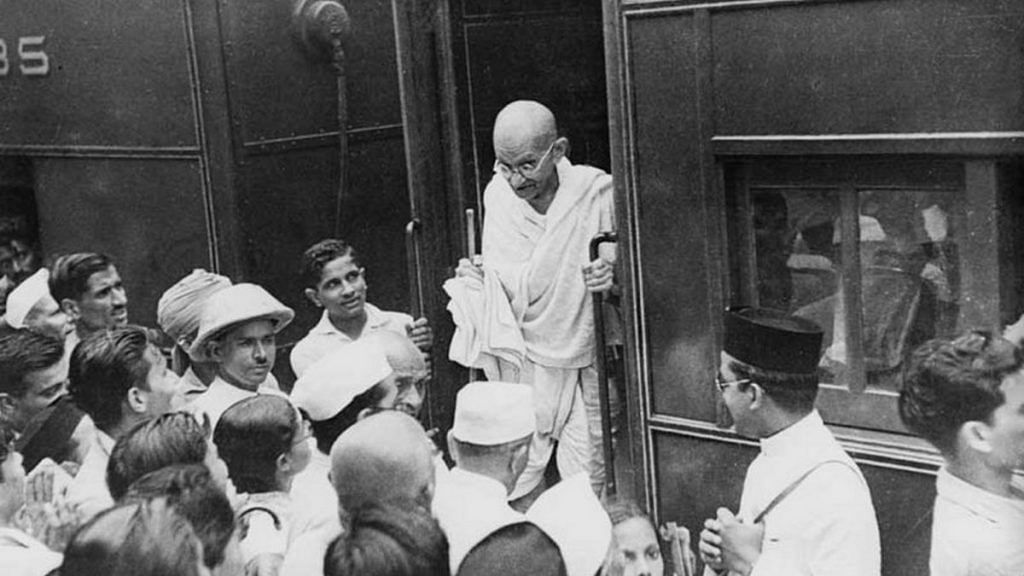I visited Gandhi Smriti in New Delhi Thursday, and, as is my ritual, went to the spot of Bapu’s assassination to pay my respect. I went inside the building, formerly known as the Birla House, to look at the display of enlarged photographs of the aftermath of Bapu’s murder and funeral, shot by the legendary French photographer Henri Cartier-Bresson. He had gifted these photographs to the Gandhi Smriti and they were prominently displayed on the walls of the lobbies.
I was horrified to find all the photographs missing and replaced by cold, dark TV screens displaying random images with no captions and reduced sizes. It took away the ethos of the warm sepia prints that artistically portrayed the events. I was hurt and then angered to know that this had been done on the orders of higher-ups – PM Narendra Modi had supposedly suggested it after his visit in November. This was unacceptable to me and I immediately tweeted my response on yet another desecration of Gandhi Smriti.
Over the years, many alterations, unnecessary ones, have erased the events that happened at the Birla House.
The first alteration was done immediately after the failed attempt on Bapu’s life on 20 January 1948, when the damage caused by the bomb explosion was repaired. Gandhi was staying at the Birla House and conducting his meetings when a grenade was hurled at the crowd. The repair then was understandable because it was still the home of the Birla family. But after the house was purchased and turned into a memorial, many unnecessary changes were made, which slowly started erasing historical incidents that took place there.
Visitors today, sadly, don’t get to know about Bapu’s last fast and the failed attempt on his life on 20 January.
Also read: Indian liberals must reconsider their rejection of Mahatma Gandhi
Cartier-Bresson photographed a grief-stricken nation
The sepia enlargements displayed in Gandhi Smriti were done by Cartier-Bresson himself and were of high quality and photographic merit. All of them together explained the historic events that occurred there in January 1948.
One image showed Bapu’s body lying with rose petals showered on him and the sheet covering him folded back to display the three bullet wounds on his chest. His son Devadas Gandhi described these bullet wounds as medals of honour for a nonviolent soldier. There was a photo of Bapu’s body being carried up the stairs to be displayed on a balcony on the first floor facing the street so that the large sea of people who had gathered could see their Bapu and bid him goodbye.
The photographs showed Bapu’s watch stopped at 5:17 – the time of his murder, the gun used to murder him, a bullet recovered from the gun and his blood-stained clothes.
There were poignant photographs of the funeral litter and the funeral procession winding through Delhi streets and millions of people thronging the road, walking with the procession, some hanging from trees, electric poles and even from the King George V Memorial near India Gate.
Cartier-Bresson had photographed a grief-stricken nation, tear-streaked faces and the funeral, the last prayers offered by Bapu’s close disciples standing around the pyre. There were images of ministers and dignitaries sitting on the ground near the funeral pyre, including the Mountbatten family. The lit pyre, flames leaping up to the skies, mounted guards of the governor-general around the pyre, preventing people from getting dangerously close. Cartier-Bresson had captured Jawaharlal Nehru standing on a stool and imploring the multitude to sit down, and making his historic ‘The light has gone out of our lives…’ speech.
Together, these images and their captions explained the history and gave a very detailed and emotional description to the visitors. One panel gave the eye-witness account of American journalist Robert Trumbull, who was present at Birla House that fateful January evening. He was one of the first to inform the world about the attack on Bapu.
Also read: Why Gandhi and Ambedkar never engaged with Hedgewar, the founder of RSS
Stop desecrating Gandhi Smriti
Removing these panels felt like a conspiracy to dilute and erase the evidence of the assassination of Gandhi by those whose ideology had allowed such a tragedy. I could not remain quiet.
A concerted campaign has been carried out to spread misinformation regarding the facts about Bapu’s murder right up to a petition in the Supreme Court seeking a re-investigation on the basis of false information and fabricated evidence. The conspiracy is so vile that they have even tried to portray the murder as a suicide. A school in Gujarat asked its students to write on how Gandhi had committed suicide. It is an attempt to confuse people about history that is inconvenient to the Modi government.
The Modi government and the director of Gandhi Smriti, Dipankar Shri Gyan, explained the removal of images as part of a ‘digitisation’ project being implemented at Gandhi Smriti. It is a dishonest excuse. It is a transparent attempt at obscuring history.
The historic print panels must be restored at Gandhi Smriti. The digital panels have stolen the ethos of the artistic displays and the soul of the place. Those evocative, almost-speaking images must be put back up – every one of them – and the digital monstrosities removed.
Gandhi Smriti is a memorial to a man for whom simplicity was a religion – let his story be told in a simple, dignified manner. The Modi government must restore Gandhi Smriti to its earlier prestige and stop the attempts to desecrate it.
The author is the great-grandson of MK Gandhi. Views are personal.
